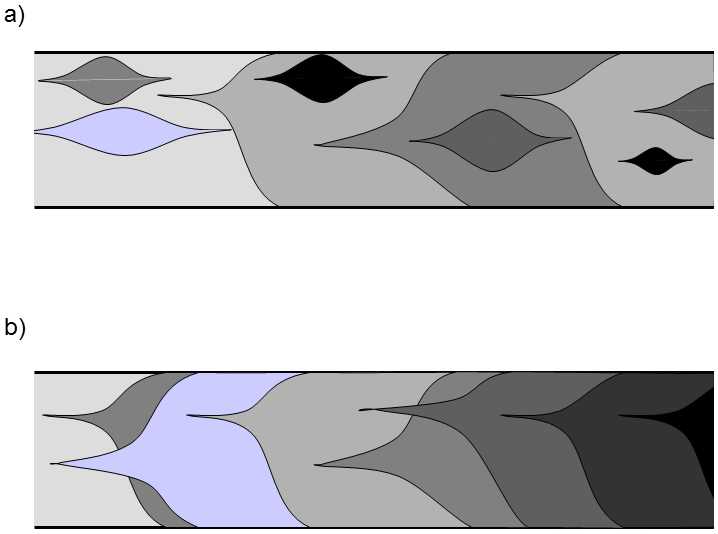XIII.3.1.4 Sexual reproduction facilitates simultaneous selection for two mutations
Only a sort of sequential evolution can occur in asexually reproducing organisms, i.e. gradual fixation of advantageous mutations in a single genealogical line (Fig. XIII.6).If several advantageous mutations

Fig. XIII.6 Parallel fixation of advantageous mutations in sexually reproducing organisms. In organisms without sexual reproduction, advantageous mutations must be fixed one after another; if two advantageous mutations appear simultaneously in the population, the more advantageous of them forces out the less advantageous mutation (a). In contrast, fixation of several advantageous mutations can occur in a sexually reproducing species as they can meet in the genome of a single individual through genetic recombination (b). However, more detailed analyses have shown that the advantage of the parallel fixation of several advantageous mutations can be utilized only under highly restricted conditions.
occur at once in the population, the carriers of various mutations will compete.Only the most successful of them will, in the end, survive and its progeny will have to again “wait” for another mutation to occur, even though it already existed in the population in the past.In contrast, in sexually reproducing species, the evolution of various traits can occur in parallel and the individual mutations are selected simultaneously in various individuals (Fisher 1958; Muller 1932).Recombinants are formed sooner or later during sexual reproduction and at least some of them carry the advantageous mutation from both parents.If the positive effect of the mutations is additive, then these recombinants and their progeny are positively selected with greater effectiveness than the original parent line (Muller 1964).Mathematical models have shown that acceleration of evolution through this effect can be significant, especially in populations of medium size {12233}.However, in normal-size populations, evolution tends to be limited by the number of newly formed mutations rather than by their mutual competition.Thus, the advantage of parallel selection is much smaller here (Crow & Kimura 1965; Crow 1994).Another reduction in the effectiveness of this process (even in large populations) follows from the Hill-Robertson effect (Hill & Robertson 1966), i.e. a reduction in the effectiveness of selection occurring in favour of several alleles at the same time (see IV.2.1).s
